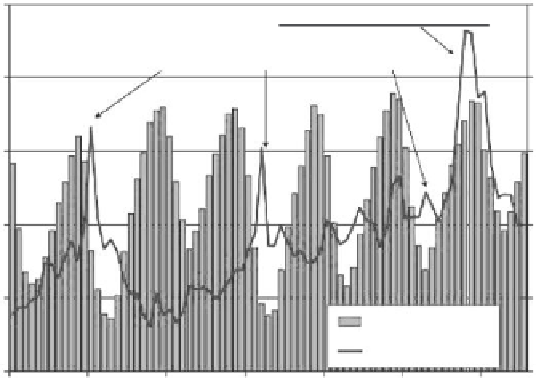Environmental Engineering Reference
In-Depth Information
North American Natural Gas Storage Levels and
NYMEX Natural Gas Prices
Storage
(Bcf )
US$/MMbtu
5,000
$15.00
High Storage and High Prices
High Prices - Low Storage
$12.00
4,000
$9.00
3,000
$6.00
2,000
$3.00
1,000
Storage
NYMEX Gas Price
0
2000
Sources: EIA, GLJ
$0.00
2001
2002
2003
2004
2005
2006
FIGURE 8.7
North America natural gas storage levels, 2000 through 2006.
who use storage as a marketing tool (hedging or speculating) will delay stor-
ing large quantities when prices are high.
As with all infrastructural investments in the energy sector, developing stor-
age facilities is capital-intensive. Investors usually use the return on invest-
ment (ROI) as a financial measure to determine the viability of such projects. It
has been estimated that investors require a rate of return between 12 and 15%
for regulated projects and close to 20% for unregulated projects. The higher
expected return from unregulated projects is based on higher perceived mar-
ket risk. In addition, significant expenses are accumulated during the planning
and location of potential storage sites to determine their suitability, and this
further increases the risk. The capital expenditure to build a facility depends
primarily on the physical characteristics of the reservoir. The development
cost of a storage facility largely depends on the type of storage field.
As a general rule, salt caverns are the most expensive to develop on a
billion-cubic-feet-of-working-gas-capacity basis. However, keep in mind that
the gas in such facilities can be cycled repeatedly on a deliverability basis and
thus may be less costly. A salt cavern facility may cost $10 million to $25 mil-
lion per billion cubic feet of working gas capacity [4]. The wide price range
is the result of region differences that dictate the geological requirements.
These factors include the amount of compressive horsepower required, the
type of surface, and the quality of the geologic structure.


